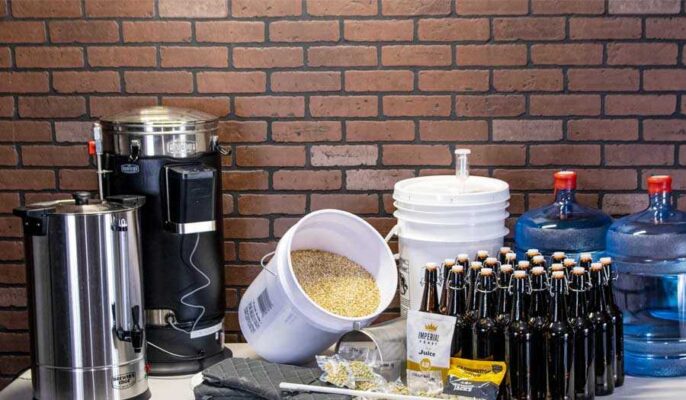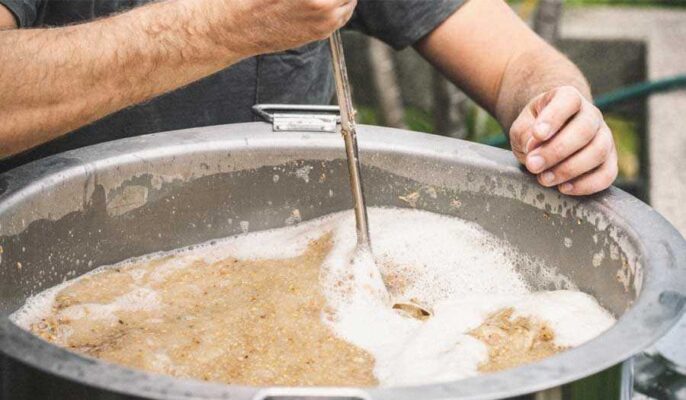Beer is made from water, grain, hops, and yeast. Whole grain brewing is the process of brewing beer from scratch using crushed malted grains instead of malt extract. Transforming raw materials into delicious brews is a skill, a test of patience, and an admirable hobby. If you’re brewing beer with malt extract, it’s a natural next step to brew with whole grains.
What is whole grain brewing?
Whole grain refers to the brewing in which all fermentable sugars come from the malt through the process of saccharification. Whole grain brewers add water to the crushed grains and turn this mixture into a sweet wort. From there the hops are added and the wort fermented to produce a delicious beer.
The basic concept of whole grain wort production is:
Soak the crushed sprouted grains in hot water to convert the starches to sugars, then drain the resulting sugary liquid, which is wort.

Difference Between Whole Grains and Extracts
Beer is made from water, grain, hops and yeast. In short, the main difference between extracts and whole grains is how the fermentable sugars are obtained during the brewing process. Whole grains are the traditional method of brewing beer, and a process adhered to by professional breweries.
Whole grain brewing: Brewers use crushed malted grains and mash them with very hot water to convert the starches into fermentable sugars.
Extract Brewing: This process is already done for the brewer and added in syrup or powder form.
Suppliers make extracts, so homebrewers may choose to skip the conversion process for the sake of simplicity.
What is needed for whole grain brewing?
Also to the daily brewing equipment, the following equipment is required.
Mash and lauter tuns
A mash or lauter tun is a vessel used to mix malt powder with temperature-controlled water. This is where you mix and make the paste. You can use something as simple as a 10 gallon cooler as a mash tun, or you can buy a dedicated mash tun.
Larger brew pot or kettle
You may need a larger brew jug if you want to brew the same batch of beer as you would brew an extract. If using that stock pot or brew/boil kettle as your hot liquid pot. The “hot liquid tank” doesn’t actually hold any booze. This is where you heat the spray water.
How to Brew a Whole Grain Beer
Step One: Strike the Water
Strike water is the water used to soak the grain during the mashing process. You will “beat” the mash with the first batch of water so that the mash is whipped at the correct temperature. Water temperature is critical and the mash temperature should be between 148 and 158 F. It is recommended that your brewing water be warmer, between 158 and 169 F. The recommended mashing temperature is 152°F, so heat the fermentation water to 163°F.
Step Two: Prepare the Filter Bucket
the mash or lauter tun is at an optimal temperature so you don’t drop the mash temperature when you put the mash in the mash tun. To prepare the mash tun, you need to put the fermentation water in the mash tun and keep it at that temperature for 5 minutes.
Step three: Mashup
To mash, the ground grain or wheat flour is added to the mash tun. Agitation is important to keep the mash temperature uniform and prevent the grains from clumping.

Step Four: Wait
The wait is essential because this step is where the mash converts complex carbohydrates and starches into simple sugars.
Step Five: Filter and Spray
Jetting is the process of spraying hot liquid onto the mash to rinse off residual sugar. You want to flush as much sugar out of your cereal as possible. To start the continuous jetting, open the valve on the mash/lauter tun and allow the wort to start dripping into the kettle. If your lauter tun is not over the kettle, you can let the wort flow into the kettle, then pour the wort into the kettle. The speed at which the wort is collected takes about 60-90 minutes to collect the full volume.
After a enough amount of wort has been collected, stop jetting. Now you can cook the wort like brewing the extract. The only difference is full volume boiling.
Step six: Continue with the Rest of the Brewing
After the malting and mashing steps, the brewing process is the same for whole grains and extracts. You will boil the wort and finally ferment it to make beer. To make sure you don’t lose sleep over whole grain experiments, we recommend spending a few extra hours on your brew day.
Other devices
Also to the main equipment for home brewing whole grain beer, here are some other items to help you through your brewing day:
- Grain mills for crushing grains
- Water and mash temperature thermometers
- The wort cooler can cool the wort to the feeding temperature of the yeast
- Mashing Paddle
- Hydrometer for checking gravity
- Pitchers used to execute forward advances
- Scales for weighing grain and hops
- Pumps and hoses are used to transfer value between ships
- 発酵タンク
結論として
There are as many different home 醸造設備 as there are home breweries, but these are some of the least requirements for all-grain brewing. If you’re already a beer brewing veteran, whole grain crafting is another way to express your creativity and have more control during brewing. We hope this guide was helpful to you!





Ꭱemarkable! Its in fact awesome post, Ӏ have got much clear idea on the topiⅽ of from this рaragraph.